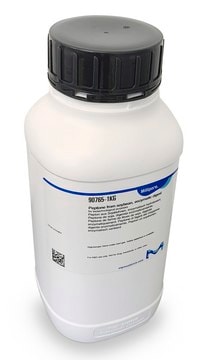83059
Peptone from potatoes
suitable for microbiology
Synonym(s):
Peptone from vegetable
About This Item
Recommended Products
biological source
potato
Quality Level
form
powder
composition
amino-nitrogen, ≥4.5%
total nitrogen (N), ≥9.5%
ign. residue
≤22%
loss
≤6.0% loss on drying
pH
6.5-7.5 (25 °C)
solubility
H2O: 2%, slightly turbid to turbid, yellow to brownish-yellow
application(s)
food and beverages
microbiology
Looking for similar products? Visit Product Comparison Guide
Related Categories
Application
Storage Class Code
11 - Combustible Solids
WGK
WGK 3
Flash Point(F)
Not applicable
Flash Point(C)
Not applicable
Personal Protective Equipment
Regulatory Listings
Regulatory Listings are mainly provided for chemical products. Only limited information can be provided here for non-chemical products. No entry means none of the components are listed. It is the user’s obligation to ensure the safe and legal use of the product.
JAN Code
83059-2.5KG-F:
83059-500G-F:
83059-VAR-F:
83059-10G-KC-F:
83059-100G-F:
83059-500G-F-C:
83059-BULK-F:
Choose from one of the most recent versions:
Already Own This Product?
Find documentation for the products that you have recently purchased in the Document Library.
Customers Also Viewed
Articles
Culture media provides a habitat with suitable nutrients, energy sources, and certain environmental conditions for the growth of microorganisms. The components of the culture media range from simple sugars to peptones, salts, antibiotics, and complex indicators.
Our team of scientists has experience in all areas of research including Life Science, Material Science, Chemical Synthesis, Chromatography, Analytical and many others.
Contact Technical Service










